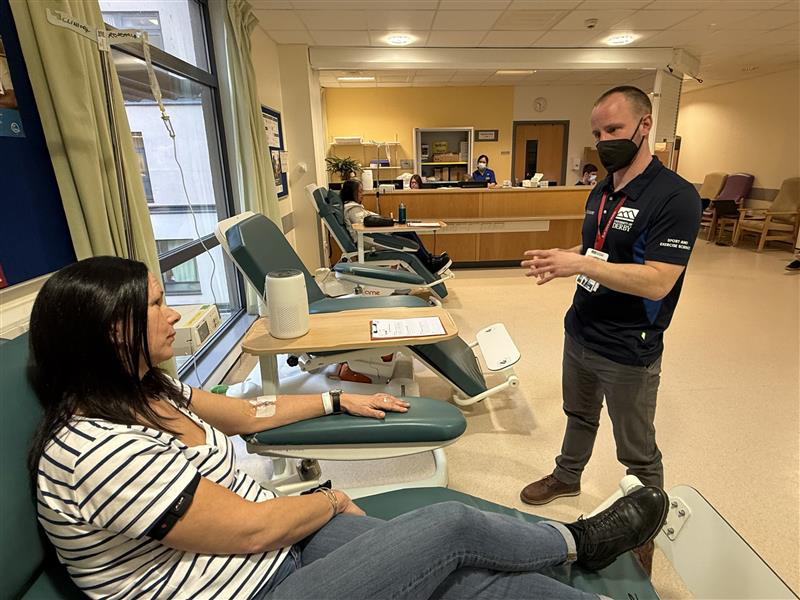No time for complacency in England’s long apprenticeship journey

Professor Tom Bewick recently attended the inaugural international conference on delivery and policy of degree and higher apprenticeships. The following article is based on the speech he gave, held at Staffordshire University on 22nd June 2023.
In 1562, the English Parliament passed the world’s first recognised national apprenticeship legislation.
The Statute of Artificers Act saw the transfer of power to regulate the supply of labour to the economy (mainly an agricultural society back then), from feudal guilds to the Elizabethan state.
It feels like this country has been in a constant dialogue about the role and purpose of apprenticeship ever since.
Whatever the century, at the heart of apprenticeship policy, you’ll find a real concern about how best to support the individual, who is in productive terms, still a novice.
How do we enable a person to find mastery in the skills required for a changing world of work?
As then, the challenge now, is broadly the same: how do we enable a person to find mastery in the skills required for a changing world of work?
As the home of Josiah Wedgewood (1730-1795), Staffordshire knows all about innovation.
Pioneering the idea of the industrial division of labour, Wedgewood was able to mass produce an array of ceramics products and export them all over the globe.
He started his apprenticeship as a potter in 1744, at the age of 14, and by the time he reached 29, he had already set up the first factory to manufacture and experiment in new glazing techniques.
As a lifelong abolitionist, Wedgewood campaigned against the slave trade.
It’s great to see the spirit of apprenticeship continues to live on in Stoke-on-Trent today; and the wider potteries. Not only the pioneering work that Staffs Uni is doing in terms of degree apprenticeships, but also the many Level 2 apprentices that are employed by Wedgewood Waterford Royal Doulton, just down the road.
In my speech today, I want to cover three questions:
- Where are we currently in England’s apprenticeship journey?
- Where are we specifically with degree apprenticeships?
- How can we work better together, both nationally and internationally, to boost all apprenticeships?
Youth unemployment
Being at an international gathering we all share a common interest in quality apprenticeship.
To differing degrees, our economies, labour markets and social models face significant strain. Youth unemployment is, on average, up to three times the rate of general unemployment in most countries.
In the UK currently, youth unemployment is 10.9 per cent (16-24 years old) – a massive waste of human talent. Yet, policymakers largely shrug their shoulders when they are challenged on the rapid decline in apprenticeships currently available for the under-25s.
So what needs to change?
We need to end such complacency as soon as possible.
It’s a few years old now, but the study by the McKinsey Centre for Government on youth employability and career transitions, provides an excellent backdrop to what we are discussing at this conference.
The researchers found that employment progression for many people these days is akin to a broken bridge. What they were referring to was the transmission mechanism in the labour market – supply and demand – is at best, opaque.
In other ways, the transmission mechanism from education into work is in crisis. Inactivity rates in Britain post-pandemic have soared, with more than 5 million people of working age counting as unproductive.
Apprenticeships are vital, because they are one of a few really established ways of repairing the broken bridge, helping individuals transition from classroom study with the applied skills required in the workplace, particularly for young people.
Skills gaps are not the figment of policy-makers’ imagination. The broken bridge metaphor is the result of labour markets functioning at a sub-optimal level. They are what the academics David Finegold and David Soskice described in the Oxford Review of Economic Policy (1988), as Britain’s woeful lack of training, leading to a ‘low-skills equilibrium.’
These economists did not imply that all firms are failing to train workers. Or that educational attainment is poor amongst every segment of the population. Rather, what we see in the empirical data – after four decades since the article was first published – is a chronic lack of UK business investment, including in apprenticeship training and skills.
Where are we currently in England’s apprenticeship journey?
It’s now over a decade since the government appointed an entrepreneur to review England’s apprenticeship system.
The Richard Review promised a step change in apprenticeship volumes and quality if the report’s recommendations were implemented.
10 years on, a dispassionate observer would have to conclude that from an apprenticeship policy performance perspective, the glass is only half-full.
The shift to new apprenticeship standards was supposed to see legions of employers spring into action. After all, the trailblazer groups convened by the Institute for Apprenticeships and Technical Education were all made up of employers, each developing and designing the apprenticeships each industry required.
Fast forward to the present day and more than 100 occupational standards have never certified a single apprentice. Hardly a great advert for a so-called employer-driven system.
Even the government, as employer, abandoned the 2.3 per cent public sector apprenticeship target when it became apparent the goal would be missed.
It’s a stark fact, but we’ve seen a 41 per cent reduction in apprenticeship opportunities for the under-25s in recent years – that’s 79,000 fewer opportunities per annum compared to before the current reforms began.
Entry-level, or level 2 apprenticeships, would usually form the bedrock of any attempt to sustain opportunities for those starting out or retraining for a new career via apprenticeship. But since the levy was introduced in 2017, the number of starts at level 2 has plummeted.
It’s resulted in a spending reduction of more than £200 million on this kind of entry-level provision. Meanwhile, spending on higher-level apprenticeships has sky-rocketed, by more than £300 million since 2017.
Where are we specifically with degree level apprenticeships?
There is a fierce argument in the sector about the reasons for this shift. Some analysts look at the nine-to-twenty-fold increase in degree (level 6/7) equivalent apprenticeships starts since 2017 and say that growth has come at the expense of level 2 and younger workers.
Civil servants argue that the introduction of the levy was always going to create winners and losers, particularly as the purchasing power of apprenticeship standards has now shifted unequivocally towards employers.
All this matters in terms of the debate about the growth of degree apprenticeships, because it’s clear that grievances are mounting up outside the HE sector. Some of my colleagues in FE see it as abominable that funding traditionally earmarked for colleges and independent training providers is now being “snaffled up” by HEIs.
The real shift, however, is on the demand-side. Employers, when faced with a choice of how to spend their levy, are doing so by adopting higher level apprenticeship standards. Individuals, including many under 25-year-olds, are also opting for the level 6 apprenticeship route because it enables them to achieve a degree without the graduate debt.
And who can blame them?
Whether it’s fair that HEIs can access the levy pot, but FE and ITPs cannot currently access the Student Loans Company funds for provision below degree level, is a moot point.
Perhaps opening up the entire £20 billion government currently spends on post-18 tertiary education in England, by not discriminating by institution or route, could be one way of levelling the playing field.
After all, perhaps we will only secure parity of esteem in post-compulsory education when we also see parity of resource.
That said, we shouldn’t let the current furore about the collapse in level 2 apprenticeships and the growth of level 6-7 starts act as a reason not to wholeheartedly get behind the continued expansion of a strong degree-level ‘earn and learn’ route.
Only a third of employers say that graduates have the required skills when they join the workforce.
Going back to the McKinsey report I referenced earlier, only a third of employers say that graduates have the required skills when they join the workforce.
The Office for National Statistics (ONS) estimates that a third of UK-born degree alumni were in non-graduate jobs in 2019. And the Treasury estimates that half of all HE loans in the UK will never be paid back.
It all adds up to a tragic waste of human potential and a gigantic loss of public money.
Degree apprenticeships are helping to reinvent what higher education means in the 21st century. It’s great to see that the team here at Staffordshire University are at the forefront of bringing about such fundamental change.
My paper giving independent advice about how to boost degree apprenticeships
Last July, I was asked by the House of Commons Education Select Committee for independent advice about how to boost degree apprenticeships. You can look up the paper on the committee’s website [or access it here].
In my paper, I reminded MPs of the policy imperatives. In particular, not enough small and medium size enterprises (SMEs) are involved in apprenticeships. In fact, the numbers engaged are woeful.
When you think that there are over 4 million firms in England that could take on apprentices, currently only about 120,000 employers do so. The levy is a tax that applies to just 2 per cent of British firms.
On the supply-side, we have this massive expectations gap at the moment, where 2 in 3 people who sign up to UCAS say they are interested in an apprenticeship. Yet, in reality, only a minority will ever secure a placement.
I applaud the efforts of UCAS to put apprenticeship opportunities on their clearing platform for the first time from late 2023. The danger, however, is that perversely, it could lead to huge disillusionment amongst prospective apprentices; particularly if UCAS applicants continue to find there are simply not enough employer slots available.
This is now the central dichotomy that policy-makers have to get to grips with.
It’s why I wrote in my paper to MPs that perhaps only some kind of wage subsidy support scheme for SMEs is likely to rocket boost the numbers of degree apprentices in a significant way.
During the pandemic, as part of the various emergency measures, the government did introduce a £3000 wage subsidy element to apprenticeships, which saw a significant boost in take up. We need to learn from these recent examples of what works.
How can we work better together, both nationally and internationally, to boost all apprenticeships?
I’m a firm believer that the way to develop a world-class system of apprenticeships is to learn from the rest of the world.
That’s why this inaugural international conference at Staffs Uni is so important. I hope it will grow in future years, as policy-makers and practitioners, come together to share best practices.
The UK is a leading nation in transnational education. Higher education met the target of attracting overseas students several years earlier than planned.
England has pioneered a world leading system of higher and degree apprenticeships. The challenge is to ensure equality of opportunity for apprentices in taking up international exchange opportunities, something currently unavailable to them.
The Turing Scheme, which facilitates student exchanges in educational institutions around the globe, has done wonders to give disadvantaged learners, in particular, the experience of exploring new horizons.
But we don’t currently have a recognised international apprenticeship exchange programme.
I don’t have time here to set out fully what such a scheme would look like. But I am committed over the next few months, working with various government administrations and the tertiary education sector, to developing one.
It would be available to apprentices of all ages and all levels in our qualifications framework. Because of the pastoral and off-the-job educational support required it would have to be delivered transnationally, via a participating network of both employers and training institutions.
In conclusion, now is the time to end the complacency in large parts of the current domestic apprenticeship policy debate.
Instead, we should raise both our domestic ambitions and global horizons, just as those explorers and entrepreneurs did in the era of Elizabeth I.
FE News on the go…
Welcome to FE News on the go, the podcast that delivers exclusive articles from the world of further education straight to your ears.
We are experimenting with Artificial Intelligence to make our exclusive articles even more accessible while also automating the process for our team of project managers.
In each episode, our thought leaders and sector influencers will delve into the most pressing issues facing the FE sector, offering their insights and analysis on the latest news, trends, and developments.
Prof. Tom Bewick is the chief executive officer of the Federation of Awarding Bodies; the chief executive officer-designate of Ecctis Ltd (from 1 October 2023); and visiting professor of skills and workforce policy at Staffordshire University.












Responses